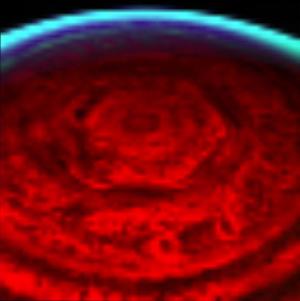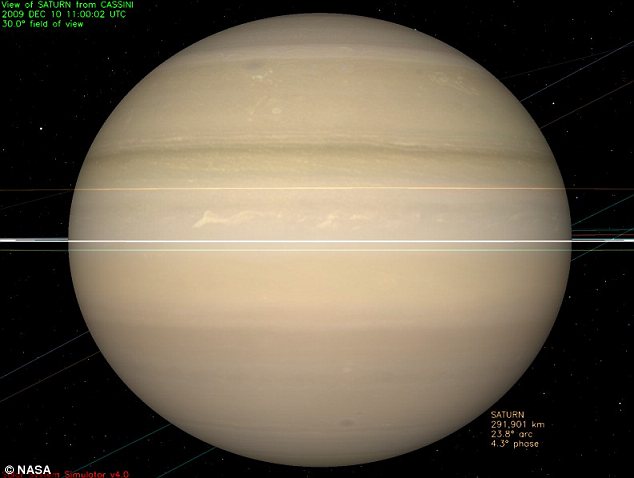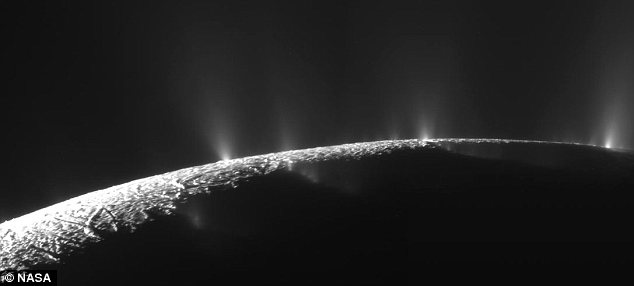
BREAKING NEWS!! -- 2:03 AM on 11th December 2009 -- New Photos From Cassini show incredible details! Saturn's mysterious hexagon crown lit up as 30-year winter ends By Claire Bates Stunning images of the intriguing hexagon shape crowning Saturn have been captured by Nasa's Cassini spacecraft. The hexagon jet stream has flowed around Saturn's north pole for at least 30 years. The image [above] was captured by the Cassini spacecraft. Scientists have waited nearly 30 years for the Sun to illuminate the ringed planet's north pole, which heralds the arrival of spring on Saturn. It has allowed them to take the most detailed pictures yet of the hexagon phenomenon, which has a diameter wider than two Earths. The images, taken from 475,000 miles away, have revealed concentric circles, curlicues, walls and streamers within the hexagon. The data will help shed light on space weather and unanswered questions about the same processes on Earth. The unusual shape is created by a jet stream flowing around the north pole, but scientists are baffled by what causes the hexagon and where it sucks in and expels its energy. They are also intrigued by how it has managed to stay organised for so long. The last visible-light images of the entire hexagon were captured by Nasa's Voyager spacecraft nearly 30 years ago, the last time spring began on Saturn.
After the sunlight faded, darkness shrouded the north pole for 15 years. Much to the delight of Cassini scientists, the location and shape of the hexagon in the latest images match up with what they saw in the Voyager pictures. 'The longevity of the hexagon makes this something special, given that weather on Earth lasts on the order of weeks,' said Kunio Sayanagi, from the Cassini imaging team at the California Institute of Technology. 'It's a mystery on par with the strange weather conditions that give rise to the long-lived Great Red Spot of Jupiter.'  A view of Saturn from the Cassini spacecraft taken today [above]. Cassini has studied the planet and its moons since 2004. The hexagon was originally discovered in images taken by the Voyager spacecraft in the early 1980s. It encircles Saturn at about 77 degrees north latitude. The jet stream is believed to whip along the hexagon at around 220 miles per hour. Saturn should give scientists a good model to study the physics of circulation patterns and atmosphere, before it does not have land masses or oceans on its surface to complicate weather the way Earth does.
 Cassini has shown Saturn's region of space to be active. In a November fly-by it recorded jets of water vapour spewing from fissures on the surface of the moon Enceladus Nasa scientist Kevin Baines has studied the hexagon with Cassini's visual and infrared mapping spectrometer. He said: 'Now that we can see undulations and circular features instead of blobs in the hexagon, we can start trying to solve some of the unanswered questions about one of the most bizarre things we've ever seen in the solar system. 'Solving these unanswered questions about the hexagon will help us answer basic questions about weather that we're still asking about our own planet.' The Cassini team plan to search the new images for clues, taking an especially close look at the newly identified waves that radiate from the corners of the hexagon - where the jet takes its hardest turns - and the multi-walled structure that extends to the top of Saturn's cloud layer in each of the hexagon's six sides. Scientists are also particularly intrigued by a large dark spot that appeared in a different position in a previous infrared image from Cassini. In the latest images, the spot appears in the 2 o'clock position. The Cassini-Huygens mission is a cooperative project of NASA, the European Space Agency and the Italian Space Agency. Original article on Viewzone 2006 An odd, six-sided, honeycomb-shaped feature circling the entire north pole of Saturn has captured the interest of scientists with NASA's Cassini mission. This nighttime view of Saturn's north pole shows a bizarre six-sided hexagon feature encircling the entire north pole. The red color indicates the amount of 5-micron wavelength radiation, or heat, generated in the warm interior of Saturn that escapes the planet. (Credit: NASA/JPL/University of Arizona) NASA's Voyager 1 and 2 spacecraft imaged the feature over two decades ago. The fact that it has appeared in Cassini images indicates that it is a long-lived feature. A second hexagon, significantly darker than the brighter historical feature, is also visible in the Cassini pictures. The spacecraft's visual and infrared mapping spectrometer is the first instrument to capture the entire hexagon feature in one image. "This is a very strange feature, lying in a precise geometric fashion with six nearly equally straight sides," said Kevin Baines, atmospheric expert and member of Cassini's visual and infrared mapping spectrometer team at NASA's Jet Propulsion Laboratory, Pasadena, Calif. "We've never seen anything like this on any other planet. Indeed, Saturn's thick atmosphere where circularly-shaped waves and convective cells dominate is perhaps the last place you'd expect to see such a six-sided geometric figure, yet there it is." The hexagon is similar to Earth's polar vortex, which has winds blowing in a circular pattern around the polar region. On Saturn, the vortex has a hexagonal rather than circular shape. The hexagon is nearly 25,000 kilometers (15,000 miles) across. Nearly four Earths could fit inside it. The new images taken in thermal-infrared light show the hexagon extends much deeper down into the atmosphere than previously expected, some 100 kilometers (60 miles) below the cloud tops. A system of clouds lies within the hexagon. The clouds appear to be whipping around the hexagon like cars on a racetrack. "It's amazing to see such striking differences on opposite ends of Saturn's poles," said Bob Brown, team leader of the Cassini visual and infrared mapping spectrometer, University of Arizona, Tucson. "At the south pole we have what appears to be a hurricane with a giant eye, and at the north pole of Saturn we have this geometric feature, which is completely different." The Saturn north pole hexagon has not been visible to Cassini's visual cameras, because it's winter in that area, so the hexagon is under the cover of the long polar night, which lasts about 15 years. The infrared mapping spectrometer can image Saturn in both daytime and nighttime conditions and see deep inside. It imaged the feature with thermal wavelengths near 5 microns (seven times the wavelength visible to the human eye) during a 12-day period beginning on Oct. 30, 2006. As winter wanes over the next two years, the feature may become visible to the visual cameras. Based on the new images and more information on the depth of the feature, scientists think it is not linked to Saturn's radio emissions or to auroral activity, as once contemplated, even though Saturn's northern aurora lies nearly overhead. The hexagon appears to have remained fixed with Saturn's rotation rate and axis since first glimpsed by Voyager 26 years ago. The actual rotation rate of Saturn is still uncertain. "Once we understand its dynamical nature, this long-lived, deep-seated polar hexagon may give us a clue to the true rotation rate of the deep atmosphere and perhaps the interior," added Baines. The hexagon images and movie, including the north polar auroras are available at: http://www.nasa.gov/cassini and http://saturn.jpl.nasa.gov and http://wwwvims.lpl.arizona.edu . The Cassini-Huygens mission is a cooperative project of NASA, the European Space Agency and the Italian Space Agency. The Jet Propulsion Laboratory, a division of the California Institute of Technology in Pasadena, manages the Cassini-Huygens mission for NASA's Science Mission Directorate, Washington. The Cassini orbiter was designed, developed and assembled at JPL. The Visual and Infrared Mapping Spectrometer team is based at the University of Arizona. Comments: Hi, Norm L. |
Other unexplained photos on this site:
If you have a suggestion or a photo to submit, send it to:
Editor/viewzone.com
myristicin@hotmail.com